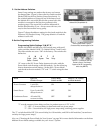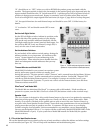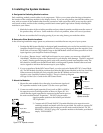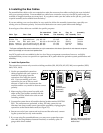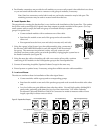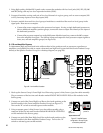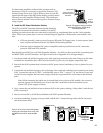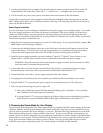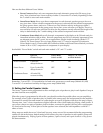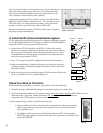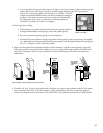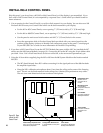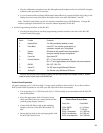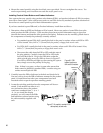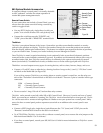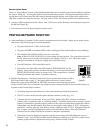
25
Here are the three different Power Modes:
• Power Conserve allows only one component from each electronic group to be ON at any given
time. New selections have a turn-on delay of either 3/4 seconds or 3 seconds, depending on how
the T switch is set on each main module.
• Smart Power Mode allows up to three components in each electronic product group to be on at
any given time. When a fourth component in the group is selected, the first selected component in
the group powers down, and so on. If there is no new selection activity in the group within 5
minutes, all components in the group power down; then, a new selection cycle begins. There is a
turn-on delay for each new selection (no delay for the products recently selected); the length of the
delay is determined by the T switch setting on the selected component’s main module.
• Continuous Power Mode allows all electronic components in the display to be ON and ready for
immediate selection with no delay. Since all components are ON it is extremely important to have
an adequate source for DC power, for car applications, like the Audio Authority
®
Model 2/77
Hybrid
™
DC Power Source. (In very large displays two 2/77s may be required if Continuous
Power Mode is used.) Choose either the Continuous Mode or the Smart Power Mode if you desire
instant A/B or A/B/C comparison of components in your display.
Set the 980’s “Power Mode” switch and each main module’s “D” and “T” switch .
Mode Effect on Power Mode Delay or “D” Switch
Product Groups Switch on 980 on Main Modules
Power Conserve 1 unit ON; ON ON
delayed turn-on
Smart Power Up to 3 units ON; OFF ON
delayed turn-on
Continuous Power All units ON; OFF OFF
no turn-on delay
Remember, T set to OFF = 3/4 second delay for head units, processors or small amps (Models 910, 958)
T set to ON = 3 second turn-on delay for large power amps (Model 942).
G. Setting the Parallel Speaker Limits.
The Access
™
System can be programmed to allow multiple pairs of speakers to play in each Speaker Group at
one time from the same amplifier.
When the system is programmed to allow this, you should consider the possible effects on your amplifiers.
For example, when 2 pairs of speakers play in parallel in the same group, the load presented to the amplifier
is increased in exactly the same manner as connecting the two pairs of speakers directly to the amp’s output.
The amp now “sees” a lower impedance or higher load and works a little harder, by playing a little louder. If
you were to choose two pairs of speakers, both at 4 ohms, connected in parallel, the two pairs would present
a 2 ohm load to the amp. If three pairs of 4 ohm speakers were selected, the load impedance could be 1.7
ohms or lower.
Many amps are stable down to a 2 ohm load, however, many are not. We recommend that the programming
switches be left at the factory default setting which allows two pairs of speakers in each speaker group to be
played simultaneously. Playing 2 pairs of front speakers, 2 pairs of rears, and a pair of subs is a very power-
ful demonstration.



